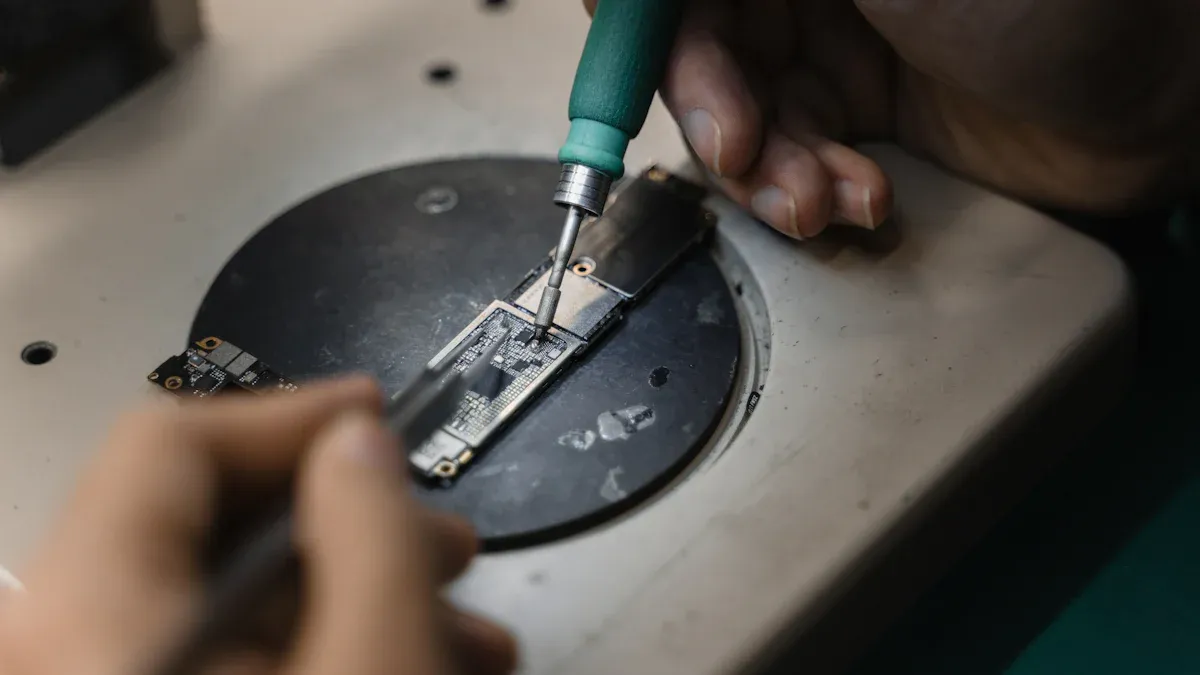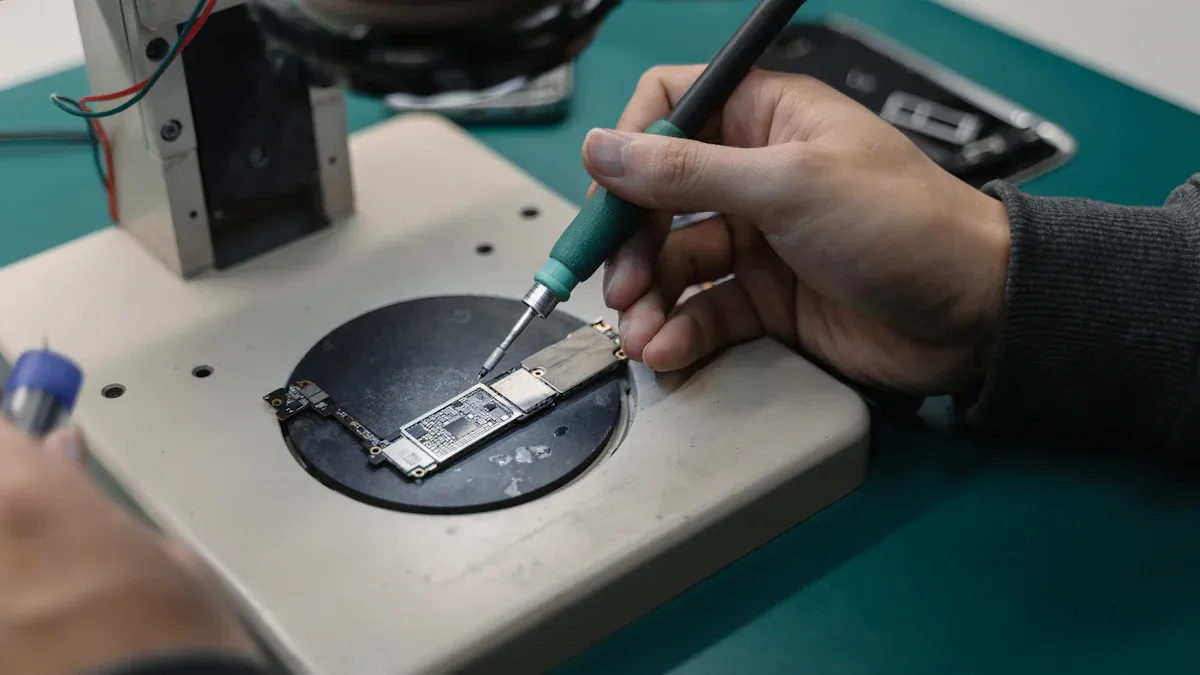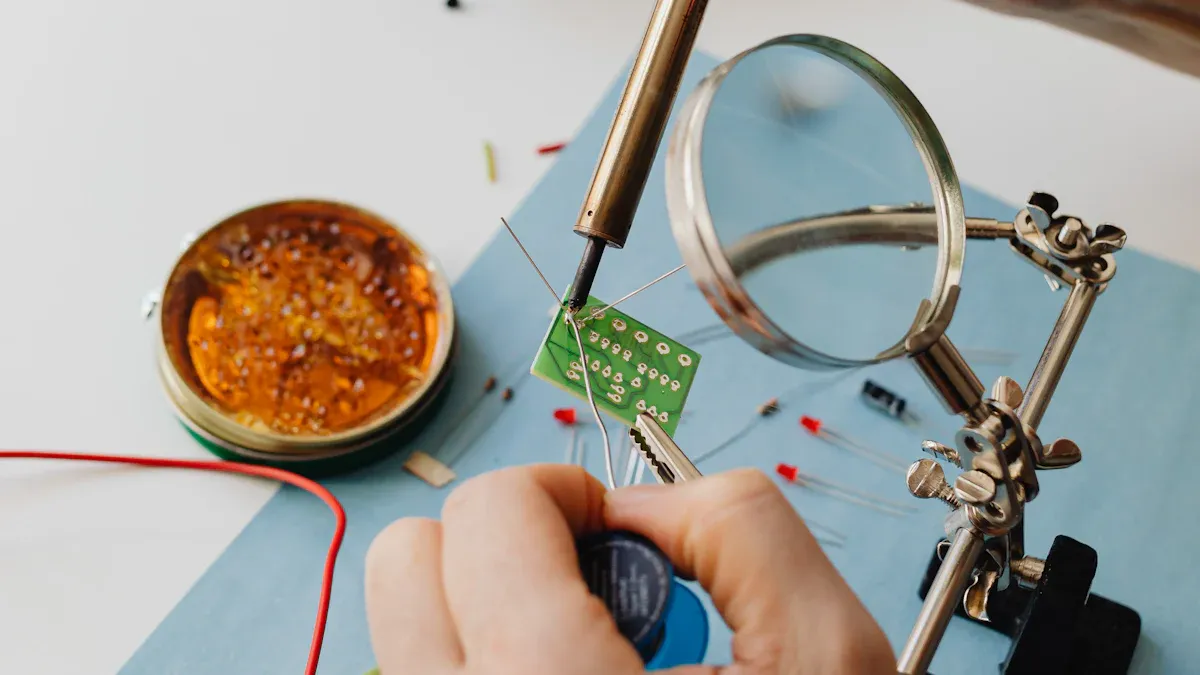
To adjust solder wave height, you need to set your soldering machine to manual mode and control the pump speed or frequency. Start by checking the preheat temperature and time, then modify the flux spray for better wettability. Next, change the soldering temperature and time to achieve proper melting. Consider the thickness of your PCB and the components’ lead length. Industry standards show that keeping the wave height near the upper limit ensures stable solder contact and heating efficiency.
-
Set the machine to manual mode.
-
Adjust pump speed or frequency.
-
Check PCB thickness and component factors.
|
Parameter |
Standard Value |
|---|---|
|
Solder temperature |
260℃ |
|
Conveyor speed |
1.0m/min |
|
Wave height |
Upper/lower limit |
Key Takeaways
-
Set your soldering machine to manual mode for direct control over wave height adjustments.
-
Maintain the solder wave height between 2-3 mm above the PCB surface for optimal solder joint quality.
-
Regularly check and adjust wave height before each production run to prevent defects and ensure reliable connections.
-
Consider PCB thickness and component lead length when setting wave height to avoid solder skips and bridges.
-
Use software controls for fine-tuning during production to stabilize solder wave height and improve soldering quality.
Why Wave Height Matters
Soldering Quality
You need to pay close attention to the solder wave height because it directly affects the quality of your solder joints. When you set the wave height too low, the solder may not reach every pad on the PCB. This can cause solder skips, which lead to weak or unreliable connections. If you set the wave height too high, you risk creating solder bridges between component leads. These bridges can cause short circuits and damage your board. Experts recommend keeping the solder wave about 2-3 mm above the board surface. This height gives you strong contact between the solder and the PCB, which helps you form solid and reliable joints. When you adjust the solder wave height correctly, you avoid common problems and improve the overall performance of your assembly.
Tip: Always check the wave height before each run. Small changes can make a big difference in soldering quality.
PCB Types
Different types of PCBs need different wave height settings. You must consider the board design and the components you use. The contact time between the solder wave and the PCB usually ranges from 2 to 4 seconds. You control this time by adjusting the conveyor speed and the wave height. Here are some important points to remember:
-
The solder wave height is a vital parameter in wave soldering.
-
Contact time between the solder wave and components is typically set to 2 to 4 seconds.
-
Conveyor speed and wave height work together to control contact time.
-
Adjusting the wave height or conveyor speed will change how long the solder touches the board.
You also need to think about the solder alloy you use. Each alloy has its own melting point and optimal bath temperature. The table below shows two common alloys and their recommended settings:
|
Alloy Composition |
Melting Point |
Optimal Bath Temperature |
|---|---|---|
|
Sn63Pb37 |
183°C |
245–265°C |
|
SAC305 |
217°C |
245–265°C |
When you adjust the solder wave height for different PCB types, you improve soldering results and reduce defects. You get better reliability and longer-lasting boards.
Adjust Solder Wave Height: Steps

Equipment Setup
You need to prepare your wave soldering machine before you adjust the solder wave height. Start by turning on the main power switch according to your equipment’s schedule. Control the solder pot switch time using the time electromagnetic valve. Next, check the solder pot temperature indicator. Use a thermometer to measure the temperature about 15mm below and above the solder pot’s liquid level. Make sure the temperature stays within ±5°C of your set value.
Check the lead cutter operation. Adjust the cutter head height based on the thickness of your PCBA. Aim for component pin lengths between 1.4 and 2.0mm. Pour flux into the fluxer and adjust the air inlet valve. Activate the fluxer and check for foaming or spraying. Adjust the flux ratio to meet your requirements.
You must also check the solder level height. If the solder is below 12-15mm from the solder pot, add solder in batches, not more than 10 kilograms each time. Clean the solder dross from the surface and add an anti-oxidant after cleaning. Adjust the transport rail angle and width to fit your PCBAs. Make sure the clamping force is moderate and the rail slope matches the pin density of your components.
Tip: Always complete these setup steps before you adjust solder wave height. Proper setup helps you avoid defects and ensures stable soldering.
Manual and Software Adjustments
You can adjust solder wave height using both manual and software methods. Set your machine to manual mode if you want direct control. Adjust the pump speed or use the frequency converter to change the wave motor speed. This action directly affects the crest height of the solder wave. You should keep the crest height stable and between half to two-thirds of your circuit board’s thickness. If the crest is too high, you may see solder joint issues like pulling or overflow. If it is too low, you risk solder leakage.
Modern machines let you use software controls for fine-tuning. You can set parameters such as dwell time, immersion depth, contact length, and conveyor speed. These settings help you achieve accurate soldering results. The table below shows important parameters to check:
|
Parameter |
Description |
|---|---|
|
Dwell time |
The time a component lead is in the solder wave, controlled in 0.1-second increments. |
|
Immersion depth |
The depth a board sinks into the wave, gauged relative to a process window. |
|
Contact length |
The distance a lead travels through the wave. |
|
Wave height |
Directly affects immersion depth and contact length; critical to measure accurately. |
|
Conveyor speed |
Impacts dwell time and immersion depth. |
|
Lead clearance |
Affects dwell time and immersion depth. |
|
Solder pump speed |
Controls wave height, which can change with solder levels and dross presence. |
When you adjust solder wave height, always consider board thickness, component lead length, and orientation. The guideline says wave height should not exceed 50% of PCB thickness. This rule helps you avoid excess solder and ensures good contact.
Note: Environmental factors like humidity and airflow can affect soldering. Adjust temperature settings to match your production environment for best results.
Fine-Tuning
You need to fine-tune your settings during continuous production to stabilize the solder wave height. Use software-based controls to make small adjustments. Change pump speed and nozzle configuration if you see any instability in the wave. Modify machine settings in real time based on board thickness and component lead length.
Here are some practical tips for fine-tuning:
-
Set solder bath temperature between 250°C and 260°C for lead-free solder.
-
Adjust conveyor speed to 1.0–1.5 meters per minute.
-
Maintain wave height so it just touches the bottom of the PCB.
-
Preheat the board to 100–120°C to prevent thermal shock.
You should create individual profiles for each PCB type. Control variables like conveyor speed, preheat temperature, and solder temperature. These steps help you keep the solder wave height stable and improve soldering quality.
🛠️ Pro Tip: Always monitor wave height during production. Small changes in pump speed or solder level can affect your results. Regular checks help you maintain optimal PCB contact and reduce defects.
You can adjust the solder wave height using these steps and techniques. This process gives you reliable solder joints and consistent quality for every production run.
Troubleshooting Issues

Uneven Peaks
You may notice uneven peaks in the solder wave during operation. This problem can cause inconsistent solder joints and lead to defects. Start by checking your wave soldering equipment. Make sure the tin furnace sits parallel to the guide rail. Clean the filter and nozzle often to prevent blockages. Adjust welding parameters such as wave crest height and preheating temperature to match your PCB specifications. Always verify the quality of your welding materials and inspect the condition of your boards. After making adjustments, run a test soldering operation to confirm improvements.
Tip: Regular cleaning and maintenance help you avoid uneven peaks and keep your solder wave stable.
Excess Solder
Excess solder can create bridges between pads and cause short circuits. You may see this issue if the soldering temperature is too low or the PCB does not preheat enough. Poor flux activity or a bad flux ratio can also lead to solder collecting in one area. Pads, plated through-holes, or pins with poor solderability trap air bubbles and prevent proper wetting. If the solder alloy contains too much copper or not enough tin, the solder becomes thick and less fluid. Solder dross can build up and enlarge the solder joint.
To prevent excess solder, control the solder wave height between 8–12 mm. Lower the wave height if you see solder collecting on leads. Keep wave pressure between 0.5–1.0 bar. Set the wave height to no more than 50% of the PCB thickness. Avoid excessive pump pressure to maintain stable waves and reduce defects.
-
Control wave height and pressure.
-
Adjust preheating and soldering temperature.
-
Use the correct flux ratio.
Solder Defects
Incorrect wave height settings often cause solder skips and poor hole fill. Solder skips happen when the solder does not reach the termination. Poor hole fill occurs when the board does not make proper contact with the solder wave. You may also see cold solder joints, which look dull and indicate weak bonding. These defects can result from low preheat temperature, improper flux application, or incorrect wave height.
You can minimize solder defects by following these preventive measures:
|
Preventive Measure |
Description |
|---|---|
|
Wave Height Control |
|
|
Lead Protrusion |
Ensure leads protrude 0.8–3 mm from the PCB surface. |
Always check your settings before each run. Adjust Solder Wave Height to match your board and component needs. This practice helps you achieve reliable solder joints and reduces the risk of defects.
Tips for Different PCBs
Single-Sided Boards
When you work with single-sided PCBs, you need to pay close attention to how you set the solder wave height. The right adjustment helps you get strong solder joints and prevents common problems. Here are some important tips:
-
Set the wave height so it contacts 50–75% of the PCB’s bottom surface. This range gives you the best solder penetration.
-
Adjust the wave height if your board has many components close together. Lowering the wave can help prevent solder bridges on dense boards.
-
Inspect the wave height often. Solder levels can drop over time, so you should adjust the height regularly to keep results consistent.
Component lead length also plays a big role in soldering quality. If you use leads that are too long or too short, you might see components lift during the wave soldering process. Leads that hit the solder bath as the board enters the wave can cause lifting. You can reduce this problem by adjusting the immersion time and the back wave section.
Tip: Always check both the wave height and the lead length before you start a new run. Small changes can make a big difference in your soldering results.
Double-Sided Boards
Double-sided PCBs bring extra challenges when you adjust the solder wave height. You must protect the components on the bottom side during the soldering process. If you do not set the wave height correctly, you risk damaging these parts. Thin boards can also face thermal shock, which may cause cracks or even delamination. These risks increase if your board uses delicate surface-mount technology (SMT) components. You need to balance the wave height to get good solder joints while keeping all components safe.
You can improve your results by using selective soldering or masking sensitive areas. Always monitor the process closely and make small adjustments as needed. Careful setup and regular checks help you avoid defects and keep your double-sided boards reliable.
Note: Double-sided boards require more attention and skill. Take your time to set up the machine and check every detail before starting production.
You improve soldering results when you adjust solder wave height correctly. You avoid defects and keep your boards reliable. Review these steps before each run. Check machine setup, pump speed, and PCB thickness. Watch for uneven peaks or excess solder. Operators benefit from training programs and certifications. The table below shows recommended options:
|
Training Program |
Description |
|---|---|
|
Wave Soldering Machine Operations |
Covers machine operation, maintenance, and troubleshooting. Encourages skill development. |
|
IPC-A-610D Certified Specialist |
Teaches acceptability requirements. Valid for two years. |
|
IPC-7711/7721 Certified Specialist |
Focuses on solder rework and repair. Valid for two years. |
-
IPC-A-610D Certified Specialist certification (valid for 2 years)
-
IPC-7711/7721 Certified Specialist certification (valid for 2 years)
📝 Tip: Always review your checklist and adjust settings for best performance.
FAQ
How often should you check the solder wave height?
You should check the solder wave height before each production run. Regular checks help you catch changes in solder level or pump speed. This habit keeps your solder joints strong and reduces defects.
What happens if you set the wave height too high?
Setting the wave height too high can cause solder bridges and short circuits. You may also see excess solder on leads. Always follow the guideline: keep the wave height below 50% of the PCB thickness.
Can you adjust the wave height during production?
Yes, you can adjust wave height during production. Use software controls or manual pump speed changes. Monitor results and make small adjustments to maintain stable soldering quality.
Does PCB thickness affect wave height settings?
PCB thickness directly affects wave height settings. Thicker boards need higher waves for good contact. Thin boards require lower waves to avoid damage. Always match wave height to your board’s thickness.
